
MAY CONTAIN NUTS

Search Shorpy
SHORPY ART

Framed or unframed, desk size to sofa size, printed by us in Arizona and Alabama since 2007. Explore now.
Join and Share
Ad-Free Shorpy
Shorpy is funded by you. Patreon contributors get an ad-free experience.
Learn more.

Recent comments
- Party of Eight?
- Good choice
- Recent view
- Hudson’s Big Store
- Say what??
- Grapes?!
- Just a Great photograph.
- A Beautiful Moment
- Such joy
- Bethune-Cookman University today
- Yellow sky at morning
- Side Winder
- Air Quality?
- Sojourner Truth riot
- None were so blind(ed)
- The less famous sister
- Good ol' days?
- Rise and Fall
- Goo Goo Ga Joob
- Ticket Retention
- Not the only one
- Vagaries of War
- Killed by Amtrak
- Back to the Future
- Wanted --
- If you can't stand the light
- Centralized Traffic Control, I believe
- What's really happening
- Heckuva remote control!
- Sometimes — Things Go Bump!
Member Photos
The Shorpy
Print Emporium
Print Emporium
Search Shorpy
Search results -- 30 results per page
- Anticipation: 1940
- ... for Thanksgiving dinner." Photo by Jack Delano for the Farm Security Administration. View full size.
Ledyard I have a cousin who ... Posted by Dave - 09/13/2011 - 11:38pm -
![Anticipation: 1940 November 28, 1940. Ledyard, Connecticut. "Family of T.L. Crouch. One of the Crouch children looking to see if the 'pudd'n' is ready for Thanksgiving dinner." Photo by Jack Delano for the Farm Security Administration. View full size.
LedyardI have a cousin who lives there but it is also the home of the famous Foxwoods Casino and is not far from Uncasville, Ct., which is the home of the Mohecan Sun Casino. The floor in this picture needs lots of repair work, the pot handles are great, I'm guessing the stove is pale green and cream and the wallpaper is most likely red designs with black accents on a cream background, I seem to remember these color combos somewhere in the back roads of my mind. I was living in southern Ct. when this picture was taken but I was not allowed to touch anything on the stove. Anywhere in New England is a great place to experience Thanksgiving. I'm thankful for this best ever website, it never fails to stir up memories that I thought were long gone. Hope ya'all have a fine family feast and love aplenty. I'm grateful for all you do for total strangers just to enrich our lives. Sincere thanks.
Thanks also to ......, besides Dave and Ken, to all the amazing talent Shorpy has attracted: stanton_square, Joe Manning, timeandagainphoto, and all those other users who know everything about everything and share their knowledge and experiences here.
[We also thank tterrace. No, we *especially* thank tterrace. On those weekends when the cupboard is bare, or think the cupboard is bare, then click on "Content" and, big ol' whew, see another example from his seemingly endless trove (it is endless, without limit, infinite and inexhaustible, right?) of phabulous photos. Oh, and Tony W. Can't forget him. I could go on, but pie awaits. - Dave]
Re: Thanks also toDitto and of course to tterrace, whose weekend gifts on Shorpy are a real treat.
O ya!Another satisfied Tterrace customer weighing in. I have a full mailbox everyday and Shorpy is the piece I open first--start my day out right. I'm thankful for all of you. I have lots of old photos but none of a quality good enough to submit, and certainly not the fabulous staging of Tterrace.
MemoriesThis reminds me of some of the earliest memories I have.
When I was 4, my mom was ill with scarlet fever and I was (literally) farmed out to the tenants on the farm my mother bought but we never lived at (I am going to post a photo of the farm, now that it is fresh in my mind).
The Dutch family's (the Doktors) suppers were cooked on this same sort of stove and in the same sort of kitchen. More memorable than the meals were the endless graces said by the father. Dinner was served blistering hot and was "just right" by the time Grace ended.
Most Thankfull!I can't tell you how much I've learned about countless things from the comments on this site. I guess you might say we have an active database! Thanks tterrace and those who have submitted the happy history that many of us have witnessed in our lifetime. It brings warm memories and will be what the future Shorpy visitors will try to sort out as we do with the LOC photos.
Pots and pans and kettles oh! my!Love the look of anticipation on the boy's face!
But what struck me even more is that my grandmother had the exact same heavy steel pot set! I still have the kettle and the low frying pan from that set and my sister has the pots and high frying pan. Quality that was built to last!
Love This!This little boy is my uncle, and he stills lives just a couple of miles from where the picture was taken. I spoke to him the other day, and he has very clear memories of this day. My mother, who using some of the other pictures taken that day, also remembers.
(The Gallery, Jack Delano, Kids, Thanksgiving)](https://www.shorpy.com/files/images/8c03868u.thumbnail.jpg)
- Hell's Kitchen: 1938
- ... County, New Jersey." Photo by Arthur Rothstein for the Farm Security Administration. View full size.
Spider heaven -- ... ... Posted by Dave - 09/09/2021 - 9:40am -
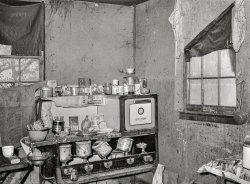
- Trunk Line: 1941
- ... Medium format acetate negative by Russell Lee for the Farm Security Administration. View full size.
... And Some Utility Poles ... Posted by Dave - 02/27/2022 - 5:03pm -
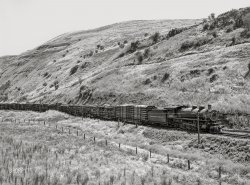
- The Orange Menace: 1941
- ... Wisconsin." 35mm nitrate negative by John Vachon for the Farm Security Administration. View full size.
As everyone knows -- the ... Posted by Dave - 09/24/2020 - 11:20am -
![The Orange Menace: 1941 July 1941. "Signs on U.S. 41, Kenosha County, Wisconsin." 35mm nitrate negative by John Vachon for the Farm Security Administration. View full size.
As everyone knows --the cheese stands alone.
Handmade SignThat's a pretty awesomely done home-made sign. No FastSigns around back then.
[These would have been the work of a professional signpainter. - Dave]
Lactose intolerance?How long did it take before the grammatically-correct local schoolmarm added either a period, or the word "for," after the word "STOP?"
I certainly can't... get behind this cause.
This was the golden agefor sign painters, later on the be a thing of the past.
I'm slow, took awhile to stopTook me five minutes to figure out this one. Kept thinking "Who'd want to stop cheese in Wisconsin? They wouldn't even let oleo be yellow.
Beautiful signI am a sign painter, and I love to see examples of hand lettering. Not much design, but it does the job and was a simple sign to "knock out". I am sure it was lettered with black and red.
This banner was most likely painted on muslin stretched on a wooden frame and then primed, a very common technique back in the day.
Badger Cheese MarketI’ve heard of goat cheese, but badger cheese?
The "Orange Menace" SignIt's a Protest sign very similar to the ones that say "End Road Work"
Nasty things, badgersI guess it takes a real man to gather enough badger milk to make cheese.
I Told You Once AlreadyCheese must be real jerk.
Heh, Heh, HehMmmmmm ... Cheese ...
(The Gallery, Bizarre, John Vachon)](https://www.shorpy.com/files/images/SHORPY-8a33181a.thumbnail.jpg)
- Cardboard Cabin: 1939
- ... Medium format acetate negative by Arthur Rothstein for the Farm Security Administration. View full size.
Some background "In an ... Posted by Dave - 06/19/2022 - 1:59pm -
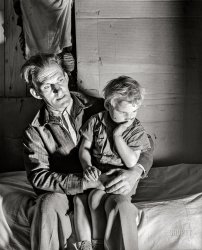
- Maid of the Marsh: 1940
- ... Medium format acetate negative by John Vachon for the Farm Security Administration. View full size.
Seeing double Would that be ... Posted by Dave - 07/02/2021 - 12:49pm -
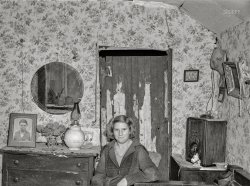
- Western Mattress: 1939
- ... cotton." 35mm nitrate negative by John Vachon for the Farm Security Administration. View full size.
Old Mattresses from 1939 ... Posted by Dave - 04/25/2012 - 11:35am -
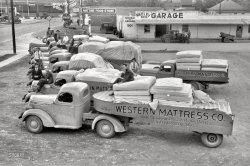
- Starry Starry Night: 1940
- ... Medium format acetate negative by Jack Delano for the Farm Security Administration. View full size.
On Route 1, I would guess I ... Posted by Dave - 05/21/2020 - 12:07pm -
![Starry Starry Night: 1940 December 1940. "Trailer parked near service station. Bath, Maine." Medium format acetate negative by Jack Delano for the Farm Security Administration. View full size.
On Route 1, I would guessI lived in Maine for 25 years, and this feels like home to me.
Heat it to beat it.I wonder if they move out of the house in the background and into the smaller trailer in the foreground because it's easier and cheaper to heat in the winter?
Looks like an "addition" has been added to the trailer to lower the chance of winter claustrophobia. That light in the window sure looks warm and homey.
[The trailers in these photos were housing for war workers at the Bath shipyard and iron works. - Dave]
The sky is fallingLook at the stars. It must have been a long exposure time and I imagine the photographer would have to be patient in that cold. But the exposure time and the cold air made the image really sharp and bright.
War of the Worlds?Either this photo was a long exposure or there was an alien attack.
Yikes!My hat is off to anyone who could drive those tall, ungainly, skinny-tired, rear-wheel-drive cars on ice like that!
The Real SkinnyHeretical though the idea may seem today, those skinny tires were quite capable in winter traction conditions. Instead of maximizing flotation, as do modern wider tires, they tended to cut through snow and ice and get to the bottom of things. However, that is not a desirable characteristic in deep mud, where it is obviously best to stay on top.
Lights, camera ...There is something about incandescent lights that make a scene feel so warm. We have three 1950s-era radial-wave streetlights on our long-ish driveway and I just love the light they cast off.
Ever Slower Grinding MoanThis frigid scene reminds me of the pleasures of starting an icy cold carbureted engine with a 6-volt electrical system. Pull out the choke, press the accelerator deeply two or three times, turn on the ignition switch, press the starter peddle with your toe, position your left foot on the accelerator peddle and hope.
A cold winter night in MaineI can just hear those 6 volt batteries groaning in the morning trying to turn those engines over.
Grinding moanI learned to drive in the seventies on an automatic, in a very cold place (Winnipeg), and my dad always warned me that on the coldest days you had only one crack. Press the gas pedal to the floor and, as you ever-so-slowly eased up on it, turn the key and don’t let up till the motor catches. If it didn’t turn over, you’d get that depressing, fading, dying sound (Phare Pleigh’s grinding moan), which meant you had to give it a few minutes rest so as not to flood it, and even then, good luck with that second try.
Hello darknessAs a kid, I marveled at the brilliance of stars in the pitch black night sky. When the mercury vapor lights started showing up on the occasional farm, they were almost like earthbound stars.
These days the sky stays a dim gray all night long from all the city lights.
I envy those folks who live out west where they can still enjoy the night.
(The Gallery, Gas Stations, Jack Delano)](https://www.shorpy.com/files/images/SHORPY-8c04035a.thumbnail.jpg)
- Le Grand Gas: 1940
- ... Medium format acetate negative by John Vachon for the Farm Security Administration. View full size.
Such a bargain. 17 cents a ... Posted by Dave - 09/30/2021 - 1:41pm -
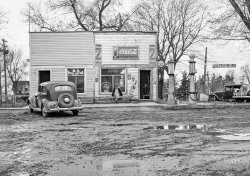
- Lunch Beer Candy: 1940
- ... Medium format acetate negative by John Vachon for the Farm Security Administration. View full size.
Still standing, but ... ... Posted by Dave - 01/12/2022 - 9:06pm -
![Lunch Beer Candy: 1940 November 1940. "Corner store in Lexington, Kentucky." Medium format acetate negative by John Vachon for the Farm Security Administration. View full size.
Still standing, but ...Hard to believe, but this building and the present structure at this site are one and the same. It was heavily "modernized" in the mid-20th century, probably after a fire. Now a popular neighborhood bar. I've been in there many times.
[Amazing! - Dave]
History in the basementThis reminds me of a neat example of how buildings evolve. A couple of years ago the owners of the bar did a major interior remodel that involved removing the floor, exposing the unfinished basement and original stone foundation. The electric water heater was oddly located along the outside basement wall, far from the kitchen or any other plumbing. Taking a look at the 1940 photo, it totally makes sense: the water heater would have been originally gas-fired and vented through the now-gone chimney. When the building was reconstructed and the heater replaced with an electric unit they probably saw no need to go to the expense of relocating it to a more logical place (which, in fact, the new owners finally did in their 2019 remodel).
Make mine a [root] beer floatI'm glad Steve Lexington knows the history of this building.
John Vachon captured so much here, from the texture of the brick streets to the swarm of power and phone lines overhead. The building in the 1940 photo has lots of charm; but I also like the musicians' mural on the building now. And I really like the 1940 guy walking around the corner -- from his aviator's cap with the earflaps secured to the knickers without boots or even knee-high socks. He is a fashion slave to no one.
Mystery Solved --Is that Amelia Earhart popping in for some lunch? Beer? Candy?
Oertles '92 - My Dad's Choice.Back in the '50s we lived in Louisville. My dad, descended from a line of brewers, only kept Oertles '92 in the house. He said it tasted like the beers his grandfather brewed. All I know is that it was the first beer that I tasted as a young child. I always got one sip anytime dad poured himself a cold one.
One stop shopLunch, Beer, Candy -
- My three basic food groups!
(The Gallery, Eateries & Bars, John Vachon, Small Towns, Stores & Markets)](https://www.shorpy.com/files/images/SHORPY-8c18409a.thumbnail.jpg)
- Mill-Industrial: 1939
- ... Medium format acetate negative by Arthur Rothstein for the Farm Security Administration. View full size.
Flour Power If you look ... Posted by Dave - 09/09/2021 - 12:51pm -
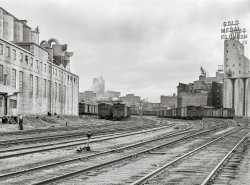
- Berkshires Picnic: 1941
- ... Medium format nitrate negative by John Collier for the Farm Security Administration.
BB&C You'd really feel that way, if you'd ... Posted by Dave - 06/19/2008 - 3:22pm -
![Berkshires Picnic: 1941 October 1941. "Picnic party from the mill towns enjoys the autumn foliage of the Berkshires along the Mohawk Trail in Massachusetts." View full size. Medium format nitrate negative by John Collier for the Farm Security Administration.
BB&CYou'd really feel that way, if you'd ever driven the Mohawk Trail! It's all twisty & narrow heading up to the mountains. Hard enough sober in those big old cars!
Beer, Beans and CoffeeJudging from the pile on the ground next to him, this guy has put back a few ales and is getting ready for some coffee so he can see straight for the long drive home. Beer, beans and coffee. Boy, I sure wouldn't want to be in that car.
Harvard AleI wonder if there'a a connection to Cambridge. Or if there was also a Yale Ale.
Essential AccessoryAn important pre pop-top accessory sits partially hidden behind the (cloth) napkin in front of the beer glass - a church key can opener! This guy only put one hole in his can. He must still be used to the earlier larger versions of the church key. We always used to put a hole on both sides of the can so air could come in through one.
[There is a big hole and partial smaller hole in each can. - Dave]
Harvard and...It's the Yale Pale Ale, I think.
Beer in a GassShirt and tie, aprons on the women, good china on the table, beer (or ale) in a glass. Picnics sure have changed. Now it's tank tops, shorts, paper plates and beer and soda straight out of the can.
Also:Lordy, but who wore a tie with a tie tack to a picnic? Man, those were the days. Men were men.
On the TableThat's an awful lot of dishes there, including saucers for the teacups. Must be before paper plates.
Can anyone read the bottle in back? It looks like Milk of Magnesia to me.
AdorableThe middle aged woman in profile, with her apron, looks so adorable. The mum I'd love to have!
Cans on groundI can spy a B&M Baked Beans Can among the beer cans on the ground.
For better or worse Change often produces less benefit than nostalgia. Plastics only became common in the fifties, so mom had to pack up half the kitchen in wicker hampers and old wooden boxes. I can remember being as happy with the new moulded plastic three well plates and aluminum 'glasses', Tartan cooler jug and Coleman aluminium chest cooler, as my folks were. They didn't have to make three trips back to the car to fetch all that heavy crockery, especially since Yerks beach at lake Ronkonkoma, NY, was down a flight of wooden steps.
(The Gallery, John Collier, Sports)](https://www.shorpy.com/files/images/8c33443u.thumbnail.jpg)
- Here's the Beef: 1941
- ... Medium format acetate negative by John Vachon for the Farm Security Administration. View full size.
Non-vegan Gazing hungrily ... Posted by Dave - 03/30/2020 - 3:39pm -
![Here's the Beef: 1941 July 1941. "The beef cut. Packing plant in Austin, Minnesota." Medium format acetate negative by John Vachon for the Farm Security Administration. View full size.
Non-veganGazing hungrily at that hunk of rib on the shelf puts me in mind of the 1748 Hogarth painting "O the Roast Beef of Old England", a detail of which is provided below.
Where's the beef?Isn't this the Hormel pork plant in Austin?
[It's the Hormel meat-packing plant. - Dave]
Beef in miniature Those are the tiniest cows I've ever seen.
[Veal calves. - Dave]
Not counting sheep tonightSuggestion: don't follow Dave's link to the LoC's Hormel plant collection right before bed.
WWII -- Serving Our TroopsWith the passing of the Lend-Lease Act of 1941, Hormel Foods shipped up to 15 million cans of meat per week overseas, most of which were products from the iconic SPAM brand. By 1944, more than 90 percent of the canned foods were shipped for government use.
(The Gallery, John Vachon, Kitchens etc.)](https://www.shorpy.com/files/images/SHORPY-8c19714a.thumbnail.jpg)
- Hotel Meade: 1942
- ... . Medium format acetate negative by John Vachon for the Farm Security Administration. View full size.
Historic Plaque In case ... Posted by Dave - 02/17/2022 - 11:20am -
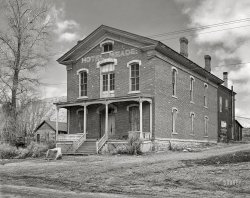
- The Ice Man: 1939
- ... full size. Medium format negative by Russell Lee for the Farm Security Administration. Here we have a very concise study in what you need for ... Posted by Dave - 04/15/2008 - 3:58pm -
![The Ice Man: 1939 February 1939. "Ice for sale. Harlingen, Texas." View full size. Medium format negative by Russell Lee for the Farm Security Administration. Here we have a very concise study in what you need for an ice business: Telephone, cash register, tongs, ice pick and a big block of you-know-what. Not to mention plenty of twine.
The SignThe piece of paper tacked to the wall says "(something) only." What is that first word?
[Employees Only. And the ice pick says SAVE WITH ICE. - Dave]
Grandpa used to say..."Every man has his woman, but the ice man has his pick!"
[That's good. Took me a second to get it. - Dave]
TwineWhat was the twine used for?
[I think they'd tie it around the ice block as a kind of handle for carrying. - Dave]
ChillinApparently to be an ice man one also needs cool socks!
Any Ice To-Day, Lady?The ice man was a big strong guy who made deliveries to women during the day while the husbands were at work - as a result, he was the subject of many jokes and rumors. In song lyrics of the day the words "ice man" stood for a lothario. The best example that I know of is the song "Any Ice To-Day, Lady" as performed by Fred Waring's Pennsylvanians on the Victor label in 1926. They couldn't be very explicit in those days, so you have to read between the lines:
Any ice to-day, lady?
It's nice to-day, lady.
How about a piece of ice to-day?
Oh, it's only a quarter,
You know that you oughter,
Hurry up before it melts away!
Yes, ma'am! Yes, ma'am!
Not on your linoleum.
No, ma'am! No, ma'am!
Giddyap, Napoleon.
Your poppa's a nice man,
And so's your old ice man,
Oh, lady be good to me!
Any ice to-day, lady?
It's nice to-day, lady.
How about a piece of ice to-day?
Tell me why you don't order,
Some Eskimo water.
Though your credit's good I wish you'd pay.
Yes, ma'am! Yes, ma'am!
I'll give you a premium.
No, ma'am! No, ma'am!
Not a red geranium.
I feel so silly,
I'll hand you a lily.
Oh, lady be good to me!
(To make things a little clearer: the next-to-last line is sung by the woman of the house, not by the ice man himself.)
My home townI grew up in Harlingen, Texas. I remember our ice box. Nasty thing. Always leaking. My mother probably bought ice from this man. Also ice cold watermelons you would "plug" to see if they were good. How did I wind up at this site?
Ice doorThe little door next to the cash register marks the chute where the block of ice would be pushed out for the customer.
TongsI remember those tongs...when Ice was delivered...those things scared me to death.
A "Cool" Sign That big bold "ICE" sign didn't hurt the business either. It just about jumps off the wall!
(The Gallery, Russell Lee, Small Towns, Stores & Markets)](https://www.shorpy.com/files/images/8b37254u_1.thumbnail.jpg)
- Tired Treads: 1937
- ... Medium format acetate negative by Russell Lee for the Farm Security Administration. View full size.
Somehow This whole thing ... Posted by Dave - 12/14/2018 - 1:52pm -
![Tired Treads: 1937 October 1937. "Used tires -- Minot, North Dakota." Medium format acetate negative by Russell Lee for the Farm Security Administration. View full size.
SomehowThis whole thing just begs for a Laurel & Hardy response. What potential for a really funny short!
Re: Ring tossOf course Dave is right. But please note, 1pictureisworth1000words: the stack on the right is on a shorter log than the one on the left, and it is NOT the log directly behind this short one, with wires attached. Look closely: there are three separate logs here. (Four, if you include the really tall one on the far right which is painted white where there are no climbing pegs.)
[Executive summary: The stack on the right is in front of a utility pole. - Dave]
Good ReceptionMost antennas ever.
Ralphie as an adult"My old man's spare tires were only actually tires in the academic sense. They were round and had once been made of rubber."
HOW ON EARTH?Just wondering how on earth they got those old tires stacked on such tall poles--especially the one that has utility wires running to and from it. My guess is that they must cut the tires to open them for placing on the stacks. Any other guesses?
[Ring toss! - Dave]
North Dakota?These were probably used to measure snow depth.
VulcanizingGet your ears pointed for free with purchase of four tires.
Hi ho the glamorous life Russell Lee must have been a real trouper. He went all the way to Minot, just to capture the majesty of these used tires. I can almost smell the filthy things.
Déjà vuNow it all makes sense.
Motto of Minot"Why not Minot?"
The answer: forty degrees below zero.
Backup motto of Minot:
"Forty below keeps the riff-raff out."
LocatedOpposite the Court House.
Mosquitoville!The clouds of bloodsuckers must have been impressive.
Pole on the rightIs used when they have to move the stack from one pole to the other while retaining the top-to-bottom order.
(Towers of Hanoi -- undergrad recursive programming exercise)
Culicidae TowersI can only imagine the number of mosquitoes growing inside those tires during warm, wet periods.
(The Gallery, Cars, Trucks, Buses, Gas Stations, Russell Lee)](https://www.shorpy.com/files/images/SHORPY-8b20081a.thumbnail.jpg)
- Movie Mecca: 1937
- ... full size. 35mm nitrate negative by Ben Shahn for the Farm Security Administration.
Mecca Money Wow, a $180 bank account! I am ... Posted by Dave - 09/09/2011 - 11:24am -
![Movie Mecca: 1937 1937. Movie theater in Crossville, Tennessee. View full size. 35mm nitrate negative by Ben Shahn for the Farm Security Administration.
Mecca MoneyWow, a $180 bank account! I am going to be there.
Inflated Peanuts?Well, after taking each monthly 1937 to 2007 dollar, via the Consumer Price Index site, and averaging them, a 1937 dollar averages $695.23, so a $180 bank account in 1937 would equal $12,514.14 dollars today. I'd take that!
[According to the CPI Inflation Calculator, a 1937 dollar has the same purchasing power as $14.60 today. So that $180 bank account would be worth $2,628. - Dave]
$180But that's purchasing power...what about savings power? It was a savings account after all.
What would $180 in 1937 be worth 71 years later, if left in a savings account earning interest (and assuming the bank didn't go bust or anything)?
[Compound interest calculator. - Dave]
MeccaWell, hell, if all I had to do was go see a movie with some friends, I'd take the $180 even now. It's a month's gas, water and electric (twice that in summer!), or two months' groceries. For a small theatre as opposed to a major corporation, that's a pretty large giveaway!
Then and NowAccording to my aunt, this theater has been called the Palace for decades. It's been restored and is used for pageants, concerts, etc.
Re: Lobby CardsLooks like the lobby cards are advertising "The 13th Chair," a mystery released in 1937 starring Dame May Whitty, Lewis Stone and Madge Evans.
See here:
http://www.imdb.com/title/tt0029661/
Lobby CardsCan we get a closeup on the lobby cards? Please.
[I'm a sucker for closeup pleading. - Dave]
Not the PalaceThis theater was at the other end of Crossville and the building still stands to this day but was gutted for the LP Shanks warehouse. It closed not long after the Palace opened in 1938.
This is a very cool photo that I've never seen before. THANKS for posting.
BoxesCan anyone make out what the boxes are stacked in front of the grocery on the left-hand side?
[Ball mason jars, for canning fruit and vegetables. - Dave]
(The Gallery, Ben Shahn, Cars, Trucks, Buses, Movies, Small Towns)](https://www.shorpy.com/files/images/8a17078u.thumbnail.jpg)
- Caroline's Kitchen: 1939
- ... Medium-format nitrate negative by Dorothea Lange for the Farm Security Administration.
sleep Don't forget to go to bed every now and ... Posted by Dave - 07/30/2012 - 2:42pm -
![Caroline's Kitchen: 1939 July 1939. Caroline Atwater standing in the kitchen door of her log house. Orange County, North Carolina. View full size. Medium-format nitrate negative by Dorothea Lange for the Farm Security Administration.
sleepDon't forget to go to bed every now and then!
Thanks for the great job you do at Shorpy (day & night), and your nice comments!
How is it possible that all your pictures have such a great resolution? If I Google around and come at several places about American history I will find (quite often) the same picture as you deliver us, but never at such a resolution.
Pure magic! Could you reveal the secret behind that?
[The original photographs don't lack for resolution. In fact the large-format cameras of 100 years ago generated higher resolution photographs than 35mm film and today's digital SLRs. The secret is taking the time to work with the high-resolution scans in Photoshop to pull out the details - Ken]
Caroline's KitchenThis photograph is just plain exquisite. Shorpy has an embarrassment of pictorial riches, but even in such estimable company, this is a standout.
I am veering far too close to obsequious gushing, so let me just say once again, "Great job, guys!"
Aunt CarolineI want to go inside and have a cuppa cawfee with Aunt Caroline. And listen to her reminisce about when she was a girl.
digitalI think you have to consider that Lange was almost invariably using a view camera. Most digital cameras are 35mm or less. Large format can be had for many thousands of dollars. Digital images are every bit as sharp as those of Lange's time - if you know how to develop them.
It almost makes me cryLooking at the detail in her dress, the wood - everything makes it so clear how much we are losing right now in this stage of digital photography. I look at the photos here daily and I sometimes feel sad that although digital has brought us an explosion of photographs - it lacks the richness of a photo like this.
Photo qualityThanks Ken, I read the whole story about your way to improve the quality at the "Jailhouse Rock: 1941" photograph
https://www.shorpy.com/jailhouse-rock#comments
great work from you guys (at least I found a name new to me: Ken, most of the time I see Dave!).
[I notice that Ken hes changed his name to "Lexybeast", is that correct? - Alex, March 27, 2020
(The Gallery, Dorothea Lange, Rural America)](https://www.shorpy.com/files/images/8b33913u1.thumbnail.jpg)
- Milk Runners: 1940
- ... Medium format acetate negative by John Vachon for the Farm Security Administration. View full size.
The Burlington Project: making ... Posted by Dave - 01/15/2022 - 12:08pm -
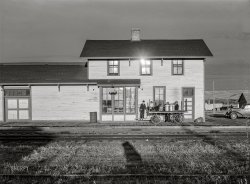
- National Market: 1942
- ... Medium format acetate negative by John Vachon for the Farm Security Administration. View full size.
That's Not Rain My ... Posted by Dave - 02/12/2022 - 1:19pm -
![National Market: 1942 April 1942. "Grocery store in copper mining center of Butte, Montana." Medium format acetate negative by John Vachon for the Farm Security Administration. View full size.
That's Not RainMy grandfather contributed to the staging of this picture.
The open window of the truck and the mostly dry street suggest the localized wet area of the sidewalk in front of the grocery store is the result of it recently being washed down with a hose, as opposed to being the remnant of a rainstorm.
At the time this picture was taken, my grandfather worked for the Butte Water Company, nice to see his handiwork preserved for posterity.
307 North Main StreetAn article in the Montana Standard gives the address, and informs us that this whole block was demolished in 1970 and is now a parking lot.
https://mtstandard.com/news/local/in-uptown-butte-even-the-parking-lots-...
The Good, the Bad and the UglyThe good: The exact location of this scene can be identified very easily thanks to the address on the truck's door - 307 North Main Street. The bad: Literally everything in the photo is gone. The ugly: It's a parking lot now. Well, at least with some trees next to it. Better than nothing.
Long Gone?I did a search for the address of this building (I got it off the truck). In the photo, it seems to me anyway, this is on a slight incline. The google.map shows this location also on an incline, but sadly it appears these two buildings are long gone. (?).
Anyway - new here - I love losing myself in wonder with the help of these photos and the commentary so many members post here.
That's my jamThere appears to be a wide selection of jams, jellies, and preserves arranged on the groaning shelves of the New National Market. I hope they have Damson Plum.
Visit ButteI think anyone who likes Shorpy would love to spend some time in Butte. I usually go for the Montana Folk Festival, which is free and is spread out around old Uptown—perfect for exploring.
[I've been to Butte, which is arranged around an enormous ore pit. Whose name would seem to suggest itself. - Dave]
(The Gallery, Cars, Trucks, Buses, John Vachon, Stores & Markets)](https://www.shorpy.com/files/images/SHORPY-8c22014a.thumbnail.jpg)
- C. City City Hall: 1942
- ... Central Colorado." Acetate negative by John Vachon for the Farm Security Administration. View full size.
Pretty much all intact ... Posted by Dave - 02/15/2022 - 11:54am -
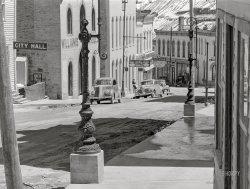
- Allouez: 1941
- ... Medium format acetate negative by John Vachon for the Farm Security Administration. View full size.
Powell Stackhouse ... Posted by Dave - 03/06/2020 - 3:01pm -
![Allouez: 1941 August 1941. "Iron ore docks at Allouez, Wisconsin." Medium format acetate negative by John Vachon for the Farm Security Administration. View full size.
Powell Stackhousehttps://www.greatlakesvesselhistory.com/histories-by-name/s/stackhouse-p...
Rustless ScupperThe Powell Stackhouse looks brand new.
What Were They Thinking?I am always amazed at the amount of commerce and industry in the Shorpy photos shown before the U.S. entered WWII. But what really amazes me is who did Germany and Japan think they were taking on when they declared war on the U.S.?
They Knew They Were SunkFollowing Pearl Harbor, Admiral Yamamoto, architect of the attack, opined that Japan would achieve victories against the U.S. for six months before beginning to lose the war. Albert Speer, German Minister of Production, concluded at the same time (according to his memoir) that the Third Reich was doomed in light of American production -- an opinion that he prudently saw fit to keep to himself.
Head ExplosionHoly Shorpy! There are so many things going on in this photo, each one regularly getting a complete photo to itself, but here we have, as supporting actors: Loco 831 with full tender AND engineer leaning out of window; a Great Lakes freighter with legible text (Powell Stackhouse, Bethlehem Transportation Corporation); railcars with iron ore as far as the eye can see; a tugboat with an angry stack; a brilliant metal dock built over 80 years ago in America; and that whole wire system strung over the railcars. Each one of these could be 20 comments, easy. Look at them all, together here! And, please, check on the map for Allouez, WI: it’s actually on Fox River, leading to Green Bay, on Lake Michigan. [Actually not: corrected by archfan to Superior, WI.] I’m loving this John Vachon trip.
Untouched by human handsInteresting. I assume they raise the hatches, lower the chutes and tip the ore cars? Efficient, if that's how they do it.
The other AllouezIt looks like the LOC description is incomplete. These are the Allouez Bay Ore Docks in Superior. The dock was also owned by the Great Northern RR. They're still standing but they ceased operations over thirty years ago.
We're Not in Green Bay AnymoreI grew up in Allouez, WI and Archfan has it right, this is not in the Green Bay area (where I still live). We had the Fox River, ships, railroads, paper industries and smoldering coal piles, but not iron ore. Today we have the same industries including a small meat packing industry which gave birth to a certain Football Team we are very proud of.
If you are a fan of U.S. history, the Green Bay area has a very rich history dating back to 1634.
Getting the ore from the cars.The ore cars have sloped bottoms like a funnel. A gateway at the bottom of the car is opened and the ore flows between the tracks to the ship. No tipping required.
Videos Show How The Ore Docks WorkYouTube has a number of videos showing how this sort of ore dock works. Most focus on the railroad aspect, but this one is more focused on the unloading, and has some good close-ups of how it works:
https://www.youtube.com/watch?v=rui21mx8RKQ
Hitler's miscalculationsAccording to histories I've read, Hitler was advised not to declare war on the U.S. after Pearl Harbor but overrode the advice for the following reasons:
1. Although Germany's mutual-defense treaty with Japan didn't obligate Germany to declare war on the U.S. after Japan became the aggressor by starting the war, Hitler said that staying neutral would make Germany look weak. He didn't want to dodge the war on a treaty technicality.
2. Great Britain was already receiving U.S. assistance through the Lend-Lease program, so declaring war on the U.S. wouldn't materially alter the balance.
3. Hitler doubted that U.S. industrial production would rise significantly if the U.S. entered the war.
4. Even if production did rise, Hitler believed his U-boat blockade would prevent the U.S. from shipping large amounts of supplies and troops across the Atlantic Ocean.
5. Even if we did move an army across the Atlantic, Americans were an inferior "mongrel race" and no match for German soldiers.
Last port of call for a doomed freighterThis is the very dock where the Edmund Fitzgerald loaded on that fateful Nov. 9, 1975.
https://www.trainorders.com/discussion/read.php?11,3885535
(The Gallery, Boats & Bridges, John Vachon, Railroads)](https://www.shorpy.com/files/images/SHORPY-8c20210a.thumbnail.jpg)
- Thresher Parade: 1941
- ... Bureau of Reclamation." Photo by Russell Lee for the Farm Security Administration. View full size.
Seeing these as a kid when out ... Posted by Dave - 04/07/2022 - 12:14pm -
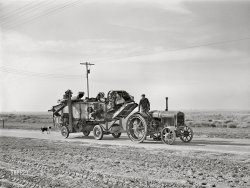
- Dacotah: 1940
- ... Dakota." 35mm nitrate negative by John Vachon for the Farm Security Administration. View full size.
It's all very different ... Posted by Dave - 12/09/2011 - 11:27am -
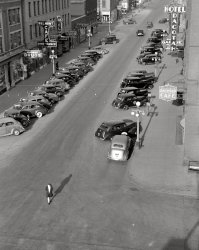
- Expert Advice: 1939
- ... Medium format acetate negative by John Vachon for the Farm Security Administration. View full size.
Yes Harold, we really do ... Posted by Dave - 02/17/2020 - 1:11pm -
![Expert Advice: 1939 September 1939. Graceville, Minnesota. "High school boy talking to druggist." Medium format acetate negative by John Vachon for the Farm Security Administration. View full size.
Yes Harold,we really do need 50 types of toothpaste AND powder.
Coty AirspunThe round orange box with the powder-puff motif hasn't changed since Airspun was introduced nearly a century ago. The loose powder (excellent product) smells like L'Origan, one of Coty's signature fragrances. Coty was about classic femininity then and still is today.
Tooth powderYou don't see that used much anymore; toothpaste has pretty much displaced it.
Guess the ProductI'd say it's Colgate tooth powder.
MayberryFloyd the Barber sells acne cream.
Re: Guess the ProductI think you're right; looking at the enlarged photo, just below the druggist's elbow, there are some containers that resemble the one he's holding. I believe they say Colgate Tooth Powder.
But -- are you sure?It'll work on jock itch? Last time you sold me tooth powder.
Wrong CaptionI love your site, and I love your captions, but surely this one should be captioned "Genius Bar".
[Perhaps a brief review is in order! - Dave]
5 & 10I understand why retailers use prices like $1.99 – it makes the price seem more dollar-y than two-dollar-y. So if a merchant, like this druggist, calls a spade a spade, and has most prices rounded out to 5 or 10 cents, then why would he still have the occasional price ending in 9 or even 8? I get using one system or another, but I don’t get the combination of the two.
Brings back memories!When we were young our mother would not buy toothpaste. We had tooth powder instead. Apparently, we loved to squeeze the toothpaste tube to the point that our consumption of toothpaste went ballistic. Our mother, who had experienced harsh times during the "dirty thirties," moved to stop this waste.
We had to sprinkle a little of the powder in the palm of one hand and dab a wet toothbrush into it. Eventually, as we got older, toothpaste was reintroduced in our home. Oh, happy day!
Floyd? Is that you?I say it is Floyd the Barber.
Love the Coty boxes!At the time this picture was taken, my mother was in her mid-teens; she's now in her 90s. And for as long as I can remember, she's always had one of those very same boxes close by! Loved looking at all the other stuff in this picture, but those really made me smile!
(BTW: my first thought on seeing this picture was of a movie scene with a 1940s kid in a drugstore: "um, I'd like some toothpaste, and gum, and a bottle of Listerine, oh, and a pack of Trojans, and some shampoo, and ... ")
In-band signalingTo davidk's question: I have seen some retailers use the last digit or two of the price to indicate the status of the item in question. For example, if the price ends in 99 cents, that's the regular price. 98 cents is a sale price, and 97 cents is a one-time special buy or a discontinued item. This was probably more common when you didn't have a computer to keep track of the current selling price for you, or label printers that could print new labels quickly for the beginning and end of a sale.
In this case, perhaps the 9-cent or 8-cent prices are items that are in an ad, maybe in the front windows of the drugstore, or in the newspaper. When the sale is over, it's easy to look at the shelf and quickly see which prices need to be changed back to a 5-cent or 10-cent price.
(The Gallery, John Vachon, Stores & Markets)](https://www.shorpy.com/files/images/SHORPY-8c16919a.thumbnail.jpg)
- Real [Blank] Spaghetti: 1940
- ... been painted over. 35mm negative by John Vachon for the Farm Security Administration. View full size.
You might think all spaghetti ... Posted by Dave - 11/20/2011 - 6:30am -
![Real [Blank] Spaghetti: 1940 November 1940. "Greek restaurant in Paris, Kentucky." Mussolini's Fascist regime has just invaded Greece, and the word ITALIAN has been painted over. 35mm negative by John Vachon for the Farm Security Administration. View full size.
You might think all spaghetti was ItalianBut my ex mother-in-law made spaghetti sauce using Campbell's tomato soup with Velveeta cheese and bologna. This was circa 1955 in Lexington. Kentucky was and is nice (I went to U of Ky), but Connecticut is better for Italian food.
First we stop at Nick'sfor a plate of unknown spaghetti, then next door to pick up a new Chevy.
Real Spaghetti SandwichesYum! I bet those are good sandwiches. After lunch I think will go and buy a Hevrolet.
Axis powerWhy would they black out "Italian." Perhaps it has something to do with the run-up to WWII.
[Perhaps it was WWII itself, and the caption explains it. - Dave]
Childhood RhymeWhistle while you work,
Hitler is a jerk,
Mussolini
Is a meanie,
Whistle while you work.
As for the "real spaghetti sandwiches," we actually had a kid in our class who brought those from home for lunch as most families had little meat. Also sardine sandwiches, plain mayonnaise sandwiches, etc. I kind of like going back to the 40's since even after 70+ years I still remember those friends and conversations. I have read that your childhood friendships were the real thing because little kids have not developed the phoniness, social obligations, artificiality or opportunism persona, but accept each other at face value. I miss my old friends, but I digress, I'll shut up now.
LSMFT in the '40s"Lucky Strike Means Fine Tobacco." It also could mean "Lord Save Me From Truman." Heard it both ways many times in the late '40s and early '50s.
No Italian spoken hereMy stepsister, who was Icelandic, spoke Italian. We lived in the U.S. from 1941 to 1944, when she was 7-9 years old, but she refused to utter a word in that language. I only spoke Icelandic and Danish, so I didn't have that problem.
I wish I still had my Hitler button. It had a string that brought Der Führer up with a noose around his neck when you pulled it. It was an interesting time for us kids, totally oblivious of the horrors of war, although we saw saw some action in October of 1941, when the convoy we were a part of was attacked by German subs. We didn't get hit, but we saw the Reuben James get it. Woody Guthrie wrote a song about that historic sinking.
Eating for successI know it is not the intent of the sign, however, I have had spaghetti sandwiches even recently. Best eaten on an Italian roll with smashed meat balls, a good sauce and sprinkled cheese. During the Depression, my mother took baked bean sandwiches to school. Other kids made fun, so she told them she loved baked beans so much that she asked her mother to make her lunch with them. Somehow, even hungry, the kids made it through and obtained a fine education. Now the kids get free school lunches - complain about them, and get lower test scores than ever. There must be a moral to learn there somewhere.
Rue Principale, Paris (KY)Nick's is now Charles' Barber Shop, and the Chevy dealership is an antique mall.
View Larger Map
Couldn't resist!Love the juxtaposition of old and new!
Mayo clinicNothing wrong with eating cheaply, so long as you're eating. When my dad was a student at University of Florida in the 1950s, his budget allowed him to eat mostly mayonnaise sandwiches. He never complained that he despised it though -- he still loves mayonnaise to this day.
(The Gallery, John Vachon, WW2)](https://www.shorpy.com/files/images/SHORPY_8a32712a.thumbnail.jpg)
- After Taxes: 1939
- ... newspapers of the term 'concentration camps' referring to Farm Security Administration camps." Medium format nitrate negative by Russell Lee ... Posted by Dave - 09/09/2011 - 6:44pm -
![After Taxes: 1939 February 1939. "White mother with children at migrant camp. Weslaco, Texas." Background for this series of photos as recorded by Russell Lee in his notes: "Local employment men say that there was no need for migrant labor to handle the citrus and vegetable crops in the valley, the local supply of labor being ample for this purpose. Most of the local labor is Mexican and the labor contractors favor Mexican labor over white labor, partly because the Mexican will work much cheaper than whites. One white woman who was a permanent resident said that the white people who lived in the valley had no trouble with the Mexicans. The Mexicans were good neighbors, she said, always willing to share what they had. She said the white migrants who came into the valley and resented and misunderstood the Mexicans caused the trouble between the two races. Some towns in this section permit camping only in trailers. The charge for camping in tents is about fifty cents per week, including water, which in some cases must be carried four city blocks. Privies are tin, very bad condition. Garbage is collected only once a week, with large dumps of decaying fruits and vegetables scattered among the camps. Some of the white migrants in this camp were very suspicious of governmental activity, due to the use by south Texas newspapers of the term 'concentration camps' referring to Farm Security Administration camps." Medium format nitrate negative by Russell Lee for the FSA. View full size.
Seventy years agoThat's really not such a long time. I wonder how well we're going to handle the next economic rough patch? Who will be taking the pictures this time?
todayI WISH SOMEONE WOULD PUT THIS ON THE NET...I DONT KNOW HOW ... WITH THE CAPTION..THIS IS IN OUR FUTURE IF
WE CONTINUE TO NOT TALK ABOU THE ELEPAHNT IN THE LIVING ROOM.
[The "elepahnt," oddly enough, has no problem talking about crazy all-caps guy. - Dave]
Russell Lee's commentsI found Russell Lee's background comments to be fascinating. I guess even back in the 1930's labor was an issue between immigrants (illegal or legal, who knows?) and migrants from the Dust Bowl days. The faces of the mother and children tell stories of their own, don't they?
Reading MaterialThere's a book/magazine/catalog to the left behind the baby child I can't make out. Would love to know what it is/its travels.
[It's a Chesterfield cigarette ad on the back of a magazine. - Dave]
ClassThrough all her obvious hard times this lady maintains a look of dignity with her beautiful children.I hope they all had happy lives.
(The Gallery, Agriculture, Great Depression, Kids, Russell Lee)](https://www.shorpy.com/files/images/8b37154u.thumbnail.jpg)
- In the Shop: 1939
- ... Georgia." Acetate negative by Marion Post Wolcott for the Farm Security Administration. View full size.
Look the other way! The ... Posted by Dave - 04/29/2019 - 3:50pm -
![In the Shop: 1939 May 1939. "Repairing automobile motor at the FSA warehouse depot in Atlanta, Georgia." Acetate negative by Marion Post Wolcott for the Farm Security Administration. View full size.
Look the other way!The engine stand is fully rotatable and adaptable to the crazy variety of engines around then!
The Ford there is set up here to rotate around 90 degrees to the center of its axis, but since it is a very compact engine it could also attach 90 degrees to that and rotate on its crank axis. The big crank handle and gear motivate the rotation, and the two rails beside the engine hold the engine. This general sort of engine stand was supplied with a large variety of brackets to directly fit popular engines to the rails.
It had to be able to accept huge variations in length, shape and weight. There were nearly all the shapes we have now, large straight sixes, lots of straight eights, and, almost unbelievably, Cadillac made V-16's through 1940.
The long ramp leading up to the mechanic's feet provided the space needed to hold at least most of these, from flat-two Crosleys up to the 16's.
Tired engineRemember that most roads in the USA in 1937-39 and well after were dirt, maybe dirt and gravel and if in a really well off county they were dirt, gravel with a generous (sometimes) cover of heated tar. And I am pretty sure that an oil bath air filter was standard on all cars meaning copious amounts of dust made its way to the combustion chamber and the the cylinder walls making a great oil and grit very fine scrubbing compound to eat away cylinders. In this case the mechanic is probably only replacing the oil rings on the pistons. Next tear down the heads come off and the cylinders get a 20, 30 or maybe even a 60 thousandths bore, new pistons and rings, at a minimum.
Not the one the revenuers use I see the MayPops are mounted on the front wheels this time. Wouldn't want to go driving around North Georgia on those tires. Too many curves, hills, frog drowner rainstorms, and the dropoff past the berm on most roads is still pretty steep.
Appears that the FSA didn't have a laundry contract for coveralls. That one could likely stand up in the corner when doffed.
TiredNice Maypop Onionskin on the front passenger side. And the driver's side not much better.
Under the hoodI think I see the Shroud Of Atlanta, or maybe the Hood of Atlanta.
Overhaul already?That 221 cubic inch flathead V8 is being pulled from a car that's only two years old.
Also interesting to see that the Department of Agriculture had their own fleet maintenance in those days. That has been the purview of the GSA for decades now.
Two yearsI drive a 2006 car and change the oil every 3,000 miles (5,000 km here in Canada), but I don’t even bother checking the oil in between visits to the garage. Here is an engine getting yanked for repair after only two years, while my little yellow engine light went on, just the other day, for the first time ever, after 13 years.
They don't build em like that any more!That car is at most two years old and already needs engine repairs, the rest of it looks rather beat as well.
Granted it's a Dept of Agriculture vehicle so it probably spent a lot of its time on dirt roads.
The mystery of the pistonsRight where the photo turns to blur for my eyes, I think I see a bare cylinder head stud sticking up at the front of the left head. He may just be doing the sides separately, and the right bank is completed or not yet begun. There are certainly no more than four pistons on the bench. The left head is in place, with my guess being that the photographer requested symmetry and less jagged detail right there, and they dropped it back on its studs to make him happy!!
[The him was a her, and I doubt it. - Dave]
Tired tiresDefinitely not safe at any speed.
Re-ring and bearing job?There's a lot going on here. I see pistons and connecting rods laying on the bench, which makes me think he's replacing piston rings along with rod and crankshaft main bearings. But, the cylinder heads are still on, and I see the nose of the crank sticking out of the front of the block, at the bottom. I'm no flathead Ford expert, but I know that with some engines you can pull the pistons out through the bottom of the cylinders (so you don't have to pull the heads), but I don't imagine it would be easy to get them back in that way, with a ring compressor on them.
I've never seen an engine stand like that - I'm used to the type where you bolt a fixture to the back of the block using the bellhousing bolt holes, with the fixture having a sleeve on the back that fits in a socket on the stand, allowing you to rotate the engine around to get to the oil pan, crank, rods, etc. This one just doesn't look practical.
I also see that the dust cap is missing from the right front brake drum, and the spindle nut with cotter pin are exposed. This will eventually allow dirt, grit, and water into the wheel bearings, causing an early failure.
The right front tire is an Allstate, a brand sold for many years by Sears, along with Allstate-branded batteries and other items. The battery is a Firestone, so it looks like they spread the business around (or it's just expediency, for a car used out in the field, traveling through small towns).
More than just automobile enginesare being repaired here. I see a stationary engine next to the wall with the head removed and a repair tag. I can't tell what type it is, but the cooling hopper has an extension added to hold more water.
(The Gallery, Atlanta, Cars, Trucks, Buses, M.P. Wolcott)](https://www.shorpy.com/files/images/SHORPY-8c09946a.thumbnail.jpg)
- Gridle: 1942
- February 1942. Tulare County, California. "FSA farm workers' camp. Girls in the recreation room." Acetate negative by Russell Lee for the Farm Security Administration. View full size.
Combinatorics Maybe the ... Posted by Dave - 04/24/2022 - 1:41pm -
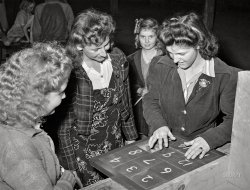
- Purr Me Another: 1937
- ... Craigville, Minnesota." Photo by Russell Lee for the Farm Security Administration. View full size.
Rough With The Smooth So ... Posted by Dave - 02/23/2018 - 5:24pm -
![Purr Me Another: 1937 September 1937. "Lumberjack at the bar on Saturday night. Craigville, Minnesota." Photo by Russell Lee for the Farm Security Administration. View full size.
Rough With The SmoothSo goes the story of a lumberjack who,
Brought his kitty into the bar bearing life's heavy load
Without a thought for himself, did with a sigh say,
"I'll have one for my baby, and one more for the road"
Ohhh I'm a lumberjack!And I'm OK.
I sleep all night and I work all day.
I cut down trees. I skip and jump.
I like to press wild flowers.
On Wednesday I pet kitties
That hang around in bars.
Long Branch saloon?Well, there's Miss Kitty.
This picture is incredibly sadI've sat here staring at it for ten minutes, trying to come up with a backstory that isn't totally depressing and tearjerking, and utterly failed.
[Spilled milk? - Dave]
Looks familiarI would not be surprised if that man is me in a past life.
Drinks, please!I'd like a "Catster", and for my little buddy, a "Hair of the Dog".
Deja vuBeen there, done that. (several times but without the cat).
SadThis picture almost makes me cry. And I'm 65 years old.
At leastHe has a job during the Great Depression, spotlessly clean hands, a full head of wavy hair and the friendship of a nice little cat. So there is hope for the lumberjack that he went on to enjoy better days.
HauntingLong time lurker here, but had to reg just to comment on this image; like others here this has haunted me. It is incredibly sad.
My photo class in college introduced me to the pics in The Family of Man - nothing in there was as profound as this.
Why hasn't this image captured all the available awards? Sarting with the Pulitzer & not stopping.
Although I have a professional printer which I use to print my art, I'm ordering a print as a Thank You for finding this image.
HauntingI enjoy coming to the site every couple weeks and reviewing old photos. Shorpy is a wonderful contribution to the internet.
Like previous commenters, this one stopped me in my tracks. What a intimate and revealing photograph, and what an incredible moment that was captured.
In a time when twitter posts about what is trending with a hashtag drive a newscycle, this photo, by comparison, arrests the mind of the viewer and depicts a shard of the man's soul.
Best, by fur!I nominate the title given to this photo as the "Most Clever" of the many Shorpy titles.
(The Gallery, Cats, Russell Lee)](https://www.shorpy.com/files/images/SHORPY-8b19906a1.thumbnail.jpg)























